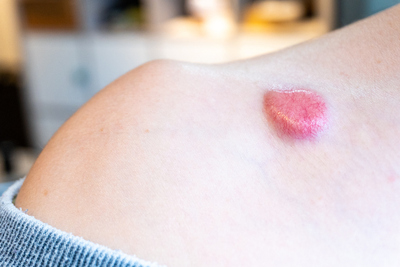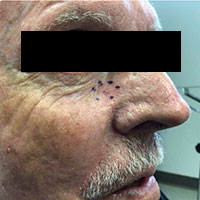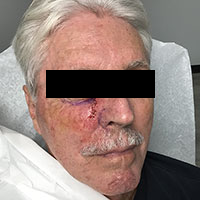Mohs Surgery for Skin Cancer
 Mohs surgery is considered the most precise and successful skin cancer treatment available today. Mohs surgery, or Mohs micrographic surgery, is the only surgical procedure for skin cancer treatment that ensures the complete removal of all cancerous cells from the skin while preserving maximum healthy skin and tissue.
Mohs surgery is considered the most precise and successful skin cancer treatment available today. Mohs surgery, or Mohs micrographic surgery, is the only surgical procedure for skin cancer treatment that ensures the complete removal of all cancerous cells from the skin while preserving maximum healthy skin and tissue.
Your Mohs micrographic surgeon will remove the cancerous tissue, analyze the lab specimens, and close or reconstruct the wound.
When Mohs Surgery is Indicated
According to the American Academy of Dermatology Association (AAD), one in five Americans will have skin cancer in their lifetime. Mohs surgery is the recommended skin cancer treatment when a basal cell carcinoma or squamous cell carcinoma:
- Is large or aggressive
- Appears in an area with little tissue beneath it (e.g., eyelid, nose, ear, scalp, genitals, hand, or foot)
- Was treated and has returned
Sometimes Mohs surgery is also recommended for patients with early-stage melanoma.
How Mohs Surgery Works
Mohs surgery is an outpatient surgery. It is performed in stages to ensure the complete removal of cancer cells. The process is as follows:
- Your Mohs surgeon examines the area to be treated and marks the spot with a pen.
- You are prepped for surgery and given a local anesthetic to numb the area. Since you are awake during the procedure, your Mohs surgeon will talk you through the process.
- A thin layer of visible cancerous tissue and a thin layer of surrounding skin is removed with a scalpel.
- The wound is cauterized, a bandage is placed over the wound, and you wait in the waiting room for the lab results.
- While you wait, the skin sample is processed in the lab and studied under a microscope to see if cancer has spread beyond the visible growth.
- If cancer cells are seen in surrounding tissue, you return to surgery, and more layers of skin are removed for further microscopic examination.
- This process may be completed multiple times until all margins are cleared of cancer cells. Most people need 2 or 3 removal procedures.
- Once all margins are cleared, the wound is either bandaged, closed with stitches, or with a skin graft–it all depends on the size and location of the wound.
Mohs Surgery Before and After​ Pictures
Surgery performed by Hamza D. Bhatti, DO, FAAD, FACMS
-

Biopsy (before Mohs Surgery)
-

During Mohs Surgery
-

Closure – Mohs Surgery
-

3 months after Mohs Surgery
Recovery from Mohs Surgery
After surgery, you may experience some localized pain, tenderness, and swelling. You may also experience some temporary bleeding from the wound. This is all normal.
Your Mohs surgeon may recommend pain medication for a couple of days after the procedure or a combination of ibuprofen and acetaminophen (Tylenol) to control any pain and swelling. Your surgeon may also recommend icing the surgical site to help reduce pain and swelling.
Healing from Mohs Surgery
You will need to rest for at least 2 days after Mohs surgery, sometimes longer. Refrain from strenuous exercise or lifting heavy items for at least 2 days or longer as recommended by your surgeon.
During the first few days or weeks, your skin may feel tight as your surgery wound heals. Over time, you will feel this less and less.
Your surgical site may even feel numb, as sometimes skin cancers may spread to involve nerves. It may take 1 or 2 years before your sensation returns to normal. In some cases, however, the numbness may be permanent.
Wound Care After Mohs Surgery
Wound care is a very important part of recovery. Your Mohs surgeon will advise you on how to take care of the wound to keep it clean and prevent infection.
You will go home with a bandage over the procedure site. Remove it only to clean the surgical site, and then reapply a clean bandage as directed by your surgeon. Typically, your surgeon will recommend that you regularly apply a petroleum jelly-based ointment, Aquaphor, or an antibiotic ointment to the wound, which will also help relieve any itch you may experience.
Scarring After Mohs Surgery
Skin surgery will leave a scar. Mohs surgeons do everything possible to minimize scarring for the best cosmetic results.
Initially, new skin grows over the would and it can have more blood vessels than the skin that was removed. This causes a red scar. The redness and sensitivity to the area will decrease over time.
Your wound can take up to 1 year to heal, and it will look better as time goes on.
Follow-Up Care After Mohs Surgery
Before you leave the surgery center, staff will schedule a follow-up visit with you to see how you are healing. The appointment is usually scheduled within 7 to 10 days after surgery.
If you have had skin cancer before, you are at an increased risk of getting skin cancer again. For that reason, you will need to come in for regular check-ups for at least 3 years after your Mohs surgery.
Effectiveness of Mohs Surgery
According to the Skin Cancer Foundation, Mohs surgery is considered to have the highest cure rate:
- Up to 98 percent for skin cancer that has not been treated before
- Up to 94 percent for skin cancer that has recurred after previous treatment
Mohs surgery ensures precise results. It is the only type of skin cancer treatment that preserves maximum healthy tissue.
Benefits of Mohs Surgery
Mohs surgery offers several benefits to patients:
- It is done in a single outpatient visit with local anesthesia and everything is done on-site.
- It offers precise, immediate results, spares healthy tissue, and leaves the smallest possible scar.
- It can be safely performed in a medical office.
Mohs Surgery at Schweiger Dermatology Group
Schweiger Dermatology Group offers Mohs Surgery at various locations in NY, NJ, PA, CT, FL, IL, MN, MO and CA. Call us at (844) DERM-DOC to check availability at a location near you.
To find a location near you, check out our location pages. We look forward to working together to find the best treatment for your skin.
Mohs Surgery FAQs
-
Is Mohs surgery painful?
During the procedure, you are given local anesthesia to numb the treatment area. Once the area is numb, you will not feel any pain during the procedure. However, after the procedure when the anesthesia wears off, it is normal to feel some discomfort and/or pain while the wound heals. Your Mohs doctor will recommend an appropriate medication to deal with any pain.
-
How long does the procedure take?
Generally, Mohs surgery can take anywhere from 3 to 4 hours, but sometimes longer. It often depends on the size and location of the skin cancer and how many rounds are needed to eradicate skin cancer cells.
-
Does Mohs surgery leave a scar?
Mohs surgery will leave a scar. Once the procedure is complete, the wound is closed. Minor wounds may only need a bandage, but if the wound is too large for a bandage or to stitch closed, a skin graft may be performed as a reconstructive solution. It is important to note that some amount of scarring is inevitable.
-
What are the risks of Mohs surgery?
In some cases of skin cancer, there may be nerve damage due to the cancer and its removal. It is also possible to experience permanent numbness in the treated area.
-
Can the cancer return after Mohs surgery?
While results show that skin cancer recurrence after Mohs surgery is quite rare, you are at a higher risk of getting another skin cancer. It is, therefore, recommended that you set up regular skin cancer screening appointments with Schweiger Dermatology Group for early detection.
-
Why should you try Mohs surgery if another surgery has not worked?
You should try Mohs surgery because it can remove all skin cancer cells. Mohs surgery finds the roots of cancer and cures almost all patients.
-
Should you avoid the sun after Mohs surgery?
After Mohs surgery, It is important to protect your skin from the sun. Follow these guidelines:
- Minimize sun exposure to the site of the surgery will be helpful for cosmetic outcomes, especially in the first few weeks.
- Apply sunscreen (SPF of 30 or more) every day to all exposed areas of your skin. This includes your face, ears, hands, and scalp.
- Reapply sunscreen every 2 hours.
- Wear a broad-brimmed hat and clothing that will cover your skin.
